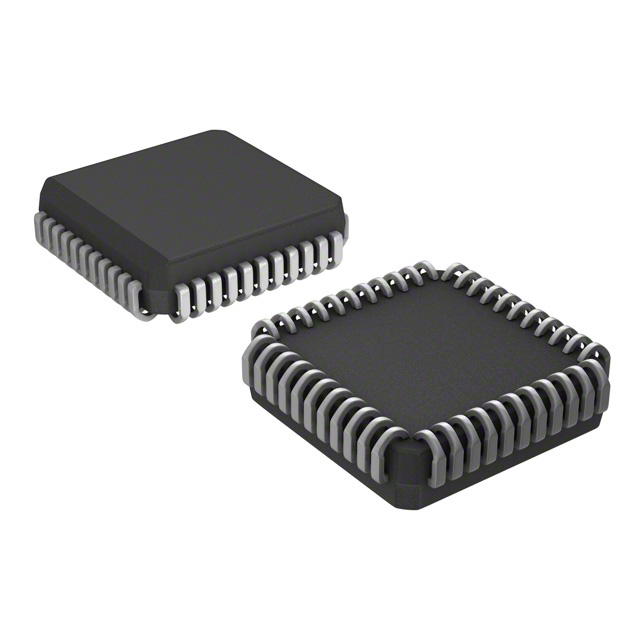Lihat spesifikasi untuk detail produk.

AT80251G2D-SLRUM
Product Overview
- Category: Microcontroller
- Use: Embedded systems, industrial automation, consumer electronics
- Characteristics: High-performance, low-power consumption, versatile
- Package: Surface Mount Technology (SMT)
- Essence: Advanced microcontroller with integrated peripherals
- Packaging/Quantity: Tape and reel packaging, 250 units per reel
Specifications
- Architecture: 8-bit
- Clock Speed: 20 MHz
- Program Memory Size: 32 KB
- RAM Size: 2 KB
- Number of I/O Pins: 32
- Operating Voltage: 2.7V to 5.5V
- Operating Temperature Range: -40°C to +85°C
- Communication Interfaces: UART, SPI, I2C
- Timers/Counters: 3 x 16-bit timers/counters
- Analog-to-Digital Converter (ADC): 8 channels, 10-bit resolution
- PWM Channels: 4
- Interrupt Sources: External and internal
- Package Type: 44-pin Quad Flat Package (QFP)
Detailed Pin Configuration
The AT80251G2D-SLRUM microcontroller has a total of 44 pins. The pin configuration is as follows:
- VCC
- GND
- P0.0
- P0.1
- P0.2
- P0.3
- P0.4
- P0.5
- P0.6
- P0.7
- P1.0
- P1.1
- P1.2
- P1.3
- P1.4
- P1.5
- P1.6
- P1.7
- P2.0
- P2.1
- P2.2
- P2.3
- P2.4
- P2.5
- P2.6
- P2.7
- P3.0
- P3.1
- P3.2
- P3.3
- P3.4
- P3.5
- P3.6
- P3.7
- XTAL1
- XTAL2
- RESET
- ALE/PROG
- PSEN
- EA/VPP
- P2.6/ALE
- P2.7/AD0
- AVCC
- AGND
Functional Features
- High-performance 8-bit microcontroller with a clock speed of 20 MHz.
- Versatile I/O capabilities with 32 pins for interfacing with external devices.
- Integrated communication interfaces (UART, SPI, I2C) for seamless data transfer.
- Multiple timers/counters for precise timing and event management.
- Analog-to-Digital Converter (ADC) with 8 channels and 10-bit resolution for accurate analog measurements.
- Pulse Width Modulation (PWM) channels for generating variable-width pulses.
- Support for external and internal interrupts for efficient event handling.
Advantages and Disadvantages
Advantages: - High-performance and low-power consumption make it suitable for various applications. - Versatile I/O capabilities enable easy integration with external devices. - Integrated communication interfaces simplify data transfer between the microcontroller and other components. - Multiple timers/counters provide precise timing control. - Analog-to-Digital Converter (ADC) allows accurate analog measurements. - Pulse Width Modulation (PWM) channels enable flexible control of output signals.
Disadvantages: - Limited program memory size (32 KB) may restrict the complexity of applications. - Limited RAM size (2 KB) may limit the amount of data that can be stored and processed. - 8-bit architecture may not be suitable for certain computationally intensive tasks.
Working Principles
The AT80251G2D-SLRUM microcontroller operates based on the principles of a typical 8-bit microcontroller. It executes instructions stored in its program memory, interacts with external devices through its I/O pins, and utilizes integrated peripherals to perform various tasks. The clock speed determines the rate at which instructions are executed, while the operating voltage ensures stable operation within the specified range. Interrupts allow the microcontroller to respond to external events promptly.
Detailed Application Field Plans
The AT80251G2D-SLRUM microcontroller finds applications in various fields, including:
- Embedded Systems: Used as the core controller in embedded systems for industrial automation, home automation, and automotive
Sebutkan 10 pertanyaan dan jawaban umum terkait penerapan AT80251G2D-SLRUM dalam solusi teknis
Sure! Here are 10 common questions and answers related to the application of AT80251G2D-SLRUM in technical solutions:
Q: What is the AT80251G2D-SLRUM? A: The AT80251G2D-SLRUM is a microcontroller based on the 8051 architecture, manufactured by Atmel.
Q: What are the key features of the AT80251G2D-SLRUM? A: Some key features include a 16-bit external data bus, 64KB of program memory, 4KB of RAM, multiple I/O ports, and various communication interfaces.
Q: What are the typical applications of the AT80251G2D-SLRUM? A: The AT80251G2D-SLRUM is commonly used in industrial automation, motor control systems, embedded systems, and other technical solutions requiring a reliable microcontroller.
Q: Can the AT80251G2D-SLRUM be programmed using C or assembly language? A: Yes, the AT80251G2D-SLRUM can be programmed using both C and assembly language, providing flexibility for developers.
Q: What voltage range does the AT80251G2D-SLRUM operate on? A: The AT80251G2D-SLRUM operates on a voltage range of 2.7V to 5.5V.
Q: Does the AT80251G2D-SLRUM support external memory expansion? A: Yes, the AT80251G2D-SLRUM supports external memory expansion through its 16-bit external data bus.
Q: What communication interfaces are available on the AT80251G2D-SLRUM? A: The AT80251G2D-SLRUM provides UART, SPI, and I2C interfaces for communication with other devices.
Q: Can the AT80251G2D-SLRUM operate in low-power modes? A: Yes, the AT80251G2D-SLRUM offers various low-power modes to conserve energy in battery-powered applications.
Q: Is the AT80251G2D-SLRUM suitable for real-time applications? A: Yes, the AT80251G2D-SLRUM is capable of handling real-time tasks due to its efficient architecture and interrupt handling capabilities.
Q: Are development tools and resources available for programming the AT80251G2D-SLRUM? A: Yes, Atmel provides a range of development tools, including IDEs, compilers, and debuggers, along with comprehensive documentation and support for the AT80251G2D-SLRUM.
Please note that these answers are general and may vary depending on specific requirements and use cases.

